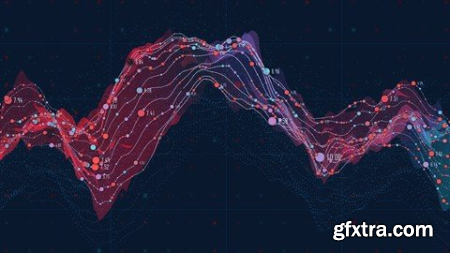
Last updated 8/2017MP4 | Video: h264, 1280x720 | Audio: AAC, 44.1 KHzLanguage: English | Size: 691.10 MB | Duration: 5h 1m
Gain hands-on experience in creating effective visualizations of your data What you'll learn Find out how to utilize visualization best practices Discover how to identify and understand your source data Get to know how to match your dataset to the appropriate visualization type See how to optimize basic chart types for maximum impact Understand, validate, and optimize your data for effective visualizations Find out the best ways to maximize the impact of basic chart types Get to know to optimize map displays Create, build, and optimize network graphs using connected data Requirements Basic knowledge of HTML, CSS, and javascript would be helpful, but is not manadatory Some experience with database, spreadsheet, and presentation software will be beneficial Description Data visualization is becoming critical in today’s world of Big Data. If you are a data analyst or a Big Data enthusiast and want to explore the various techniques of data visualization, then this Learning Path is for you! This Learning Path focus on building a variety of data visualizations using multiple tools and techniques! Packt’s Video Learning Paths are a series of individual video products put together in a logical and stepwise manner such that each video builds on the skills learned in the video before it. The highlights of this Learning Path are Learn why data visualization is important, and how it can be used to manage Big Data Learn best practices in data visualization and apply them to your own displays Let’s take a quick look at your learning journey. To start with, we will walk you through an overview of the basic principles of data visualization, why they are important, and how they can be used to make visualizations highly effective. We will then walk you through some of the basics such as how to build visualizations using best practices. You'll also learn how to identify data types and match them with the appropriate display formats.Then, we will focus on building a variety of data visualizations using multiple tools and techniques. This is where we will put the theory together with actual hands-on experience of creating effective visualizations. Our efforts will be spent on choosing the best display types for our dataset, and then applying best practice principles to our selected charts, maps, or network graphs. We will spend considerable on some of the most useful chart types, followed by a section where we explore the multiple uses of maps as visualizations. Finally, we will focus on understanding network graphs, a powerful tool for displaying relationship data. By the end of this Learning Path, you will have a strong understanding of how to effectively visualize your data. About the Author Ken Cherven has been creating data visualizations for more than 10 years using a variety of tools, including Excel, Tableau, Cognos, D3, Gephi, Sigma.js, and Exhibit, along with geospatial tools such as Mapbox, Carto, and QGIS. He has built many visualizations for his personal websites, especially utilizing Gephi and Sigma.js to explore and visualize network data. His experience in building data visualizations has intersected with many technologies, including a variety of SQL-based tools and languages including Oracle, MySQL, and SQLServer. His work is based on a thorough understanding of visualization principles learned through extensive reading and practice. He also uses his websites to display and promote visualizations, which he shares with a wider audience. He has previously authored two books on Gephi for Packt, and has also presented at multiple data visualization conferences. Overview Section 1: Learning Data Visualization Lecture 1 The Course Overview Lecture 2 Visualizing Is Critical to Understanding Lecture 3 Taming Big Data through Visualization Lecture 4 Utilizing Visualization Tools Lecture 5 Introducing Visualization Best Practices Lecture 6 Designing for Visual Clarity Lecture 7 Driving User Focus Lecture 8 Working with Element Sizing Lecture 9 Employing Color Effectively Lecture 10 Data Types Overview Lecture 11 Categorical Data Lecture 12 Series Data Lecture 13 Point (X-Y) Data Lecture 14 Geospatial Data Lecture 15 Network Data Lecture 16 Unstructured Data Lecture 17 Line Charts Lecture 18 Bar Charts Lecture 19 Scatter Plots Lecture 20 Distribution Plots Lecture 21 Dot Plots Section 2: Data Visualization Techniques Lecture 22 The Course Overview Lecture 23 Understanding the Data Lecture 24 Preparing the Data Lecture 25 Validating the Data Lecture 26 Selecting the Best Display Option Lecture 27 Creating Effective Line Charts Lecture 28 Building Powerful Bar Charts Lecture 29 Designing Effective Dot Plots Lecture 30 Building Distribution Plots Lecture 31 Creating Effective Scatterplots Lecture 32 Working with Box Plots Lecture 33 Mastering Bullet Graphs Lecture 34 Understanding Your Map Data Lecture 35 Building Dot Density Maps Lecture 36 Creating Categorical Maps Lecture 37 Designing Choropleth Maps Lecture 38 Enhancing Your Map Lecture 39 Sharing a Map Lecture 40 Creating and Procuring Network Data Lecture 41 Building a Network Graph Lecture 42 Understanding Graph Metrics Lecture 43 Styling the Graph by Sizing Elements Lecture 44 Styling the Graph Using Color Lecture 45 Sharing the Graph This Learning path is for data analysts and data enthusiasts who are looking to learn what is data visualization and its different techniques. HomePage:
Top Rated News
- Sean Archer
- AwTeaches
- Learn Squared
- PhotoWhoa
- Houdini-Course
- Photigy
- August Dering Photography
- StudioGuti
- Creatoom
- Creature Art Teacher
- Creator Foundry
- Patreon Collections
- Udemy - Turkce
- BigFilms
- Jerry Ghionis
- ACIDBITE
- BigMediumSmall
- Boom Library
- Globe Plants
- Unleashed Education
- The School of Photography
- Visual Education
- LeartesStudios - Cosmos
- All Veer Fancy Collection!
- All OJO Images
- All ZZVe Vectors




